| |
 
STRANGE BEAST
OF IDSWORTH
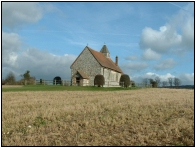 |
|
Many people claim
to have seen big cats roaming the
countryside. They write to the papers,
they talk to their disbelieving friends,
and frankly nowadays no-one takes that
much notice.
But imagine you saw a large furry animal
emerging from the forest with three paws
and one human hand. Furthermore, it has a
bearded human head with a golden light
shining like a halo around it. Then you
would have grounds to wonder what on
earth was going on, and the tabloids
would pay you a small fortune for the
story, especially if you had managed to
take a picture. |
Now such a creature does
exist, and has adorned a wall in St.
Hubert’s Chapel at Idsworth, high above the
London to Portsmouth railway line, for nearly
seven hundred years. Exactly what he is has
puzzled art historians and academics ever since
he was revealed beneath a coat of limewash in the
middle of the nineteenth century, having been
obliterated at the time of the Reformation.
The strange creature, surrounded by huntsmen, was
at first thought to represent the conversion of
St. Hubert, but this was discounted soon
afterwards, and both the Archaeological Journal
and the authoritative Victoria County History of
Hampshire claimed that it represented the Saint
curing the lycanthrope, a man whose insanity had
caused him to believe that he was a wolf.
This identification of the chapel with St Hubert
led to its re-dedication to him, rather than St.
Peter, and to claims, which could well be
correct, that it was used as a hunting chapel by
Godwin, the Saxon Earl of Wessex before the
Norman Conquest.
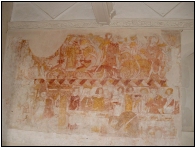 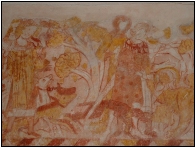 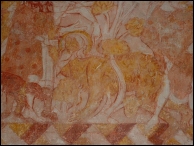
Modern scholars, however,
delving deep into mediaeval literature, claim
that no such legend exists in connection with St.
Hubert, and have put forward another
interpretation. They suggest that the picture
shows the cure of the Hairy Anchorite, who had
first seduced the daughter of a king and then
murdered her. He performed the penance of eating
grass and walking on all fours, becoming hairy
like an animal, until eventually he was
discovered by huntsmen, to whom he confessed his
crime.
It has even been suggested that there may be a
link between this and John the Baptist, scenes
from whose life are depicted in the rest of the
painting. Indeed, the strange creature’s
hind legs emerge from between the legs of the
Baptist at the moment of his arrest.
The remaining
scenes are much less distinct, but show,
on the lower tier of painting, his
Imprisonment and the Feast of Herod.
Salome, executing a sword dance in the
centre of the composition, is dressed in
a red kirtle, and bends backward so her
head almost touches the ground. In each
hand she holds a sword, whilst a dagger
is suspended above her upturned face.
Behind, Herod and Herodias are presented
separately with the severed head on a
plate.
Whatever allegorical interpretations
there may be, looking at these
extraordinarily vivid paintings today
gives us an uncanny glimpse into the
minds if our predecessors who decorated
these walls all those years ago and whose
work still exercises the minds of
scholars today. |
|
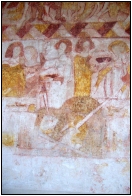 |
Tom Muckley, October 2005
This article was originally
published by the
Petersfield Post
tommuckley.co.uk
|
|






